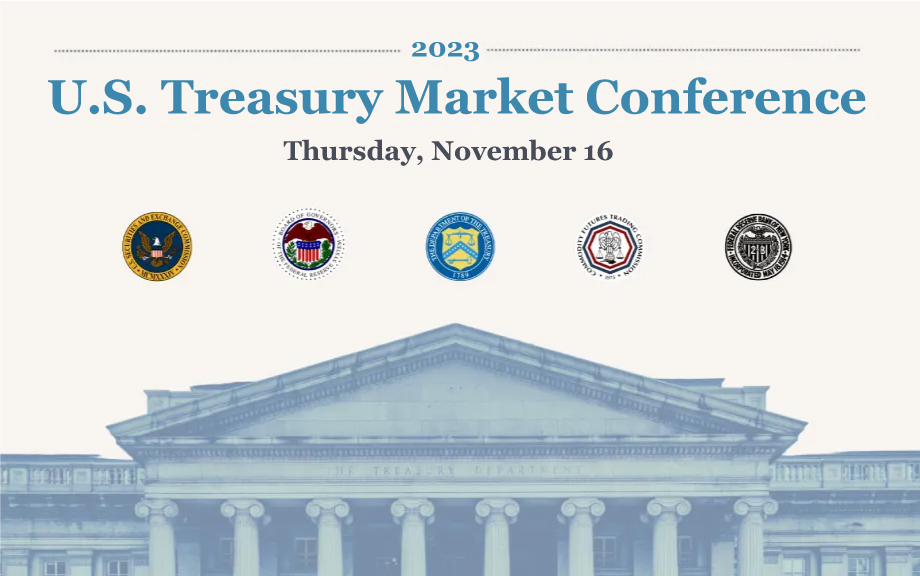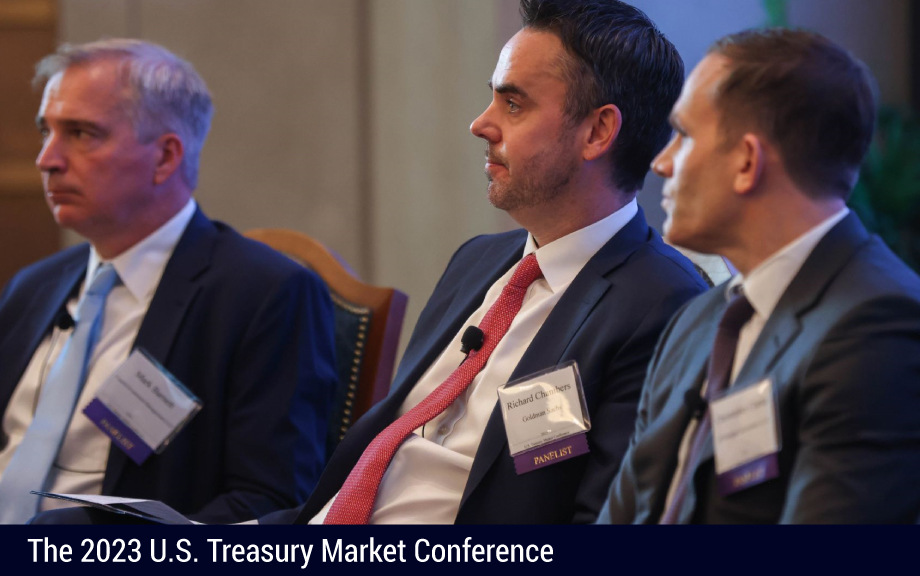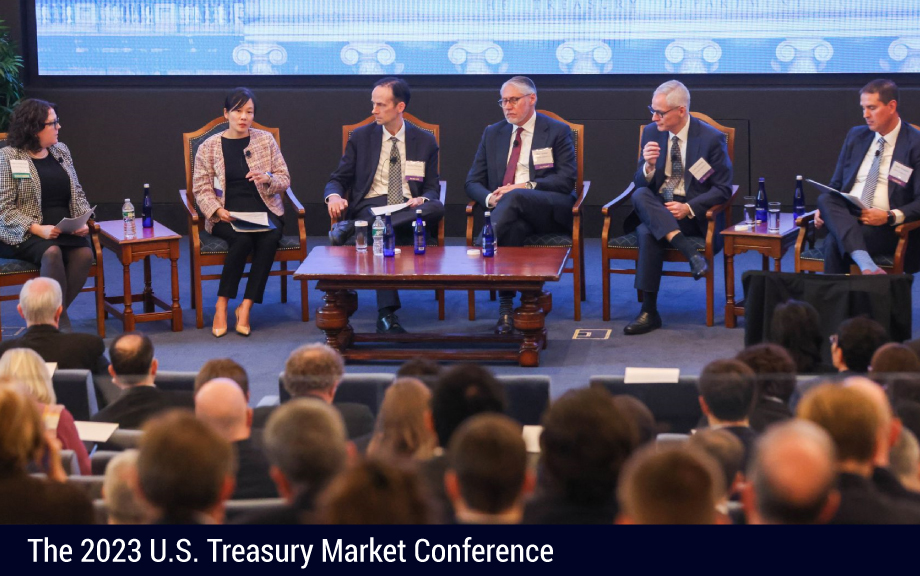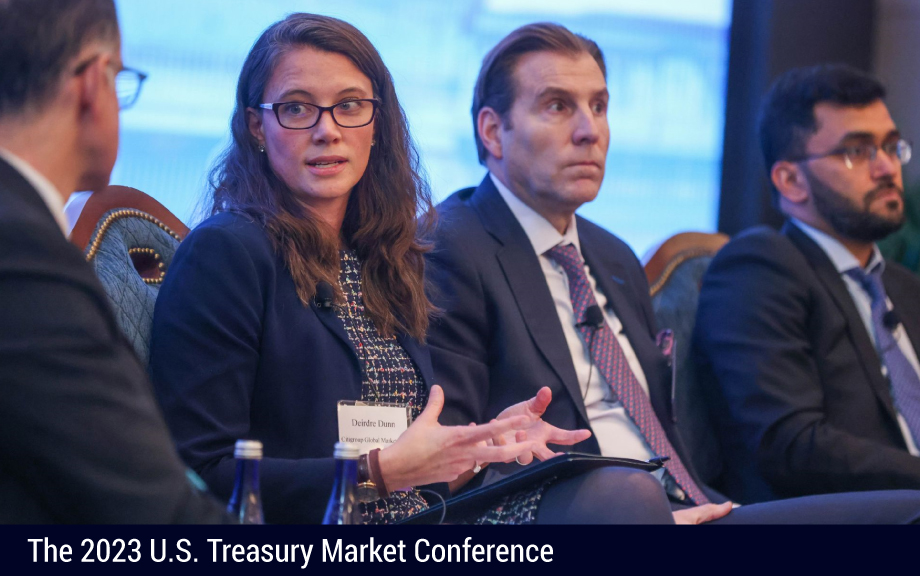
The ninth annual U.S. Treasury Market Conference, held at the Federal Reserve Bank of New York last November, brought together market participants, official sector representatives, academics, regulatory authorities, and others to discuss ongoing developments in the U.S. Treasury market. The New York Fed sponsored the conference with the U.S. Department of the Treasury, the Board of Governors of the Federal Reserve System, the U.S. Securities and Exchange Commission (SEC), and the U.S. Commodity Futures Trading Commission (CFTC). This year’s conference included several official-sector speeches and three panels.
Below, we highlight some key conference takeaways and themes. Over the next few days, we will also delve deeper into the panel discussions.
Treasury Market Liquidity and Resiliency
Treasury market liquidity has been challenged by elevated volatility, economic and policy uncertainty, and stress events over recent years. Despite this, conference participants noted the Treasury market remains resilient and the deepest, most liquid securities market in the world. Anna Nordstrom, head of Domestic and International Markets at the New York Fed, highlighted that the market’s liquidity is one of the key draws for foreign investors, who hold about $8 trillion of Treasury securities. Roberto Perli, manager of the System Open Market Account, said that the market’s resilience is critical “for monitoring the health and evolution of the broader economy…from the perspective of market participants.” In addition, many speakers said the official and private sectors can and should consider additional measures to further bolster the market’s resiliency. Some examples of additional measures discussed included enhanced data and transparency, broader adoption of central clearing and all-to-all trading, and an official sector buyback program.
Data Availability and Transparency
Several speakers stressed the importance of data availability in the Treasury market and efforts to enhance its transparency. New York Fed President John Williams emphasized the importance of “good” data, backed by transactions and not easily manipulated, and the necessary collaboration between the official and private sectors to advance data transparency. Speakers cited many potential benefits of increased transparency, including improvements in decision-making, assessments of market risk, investor confidence, liquidity, and trading costs. Areas of focus included the cash market for on-the-run Treasury securities, the less liquid off-the-run cash market, and the non-centrally cleared bilateral repo market (NCCBR). Treasury Under Secretary for Domestic Finance Nellie Liang highlighted the Office of Financial Research’s proposal to establish ongoing collection of data in the NCCBR market and a proposal by the Financial Industry Regulatory Authority (FINRA) to disseminate transaction-level data in the on-the-run market. Michelle Neal, head of the Markets Group at the New York Fed, noted that while there are valid concerns regarding enhancements to public transaction data, the success of increased transparency in other markets can provide guidance for potential implementation in the Treasury market. Vice Chair for Supervision Michael Barr discussed that recent analyses of better Treasury market data raised questions for how the official sector could support the market’s resilience. Some conference participants suggested enhanced data availability and transparency could be stepping stones to broader structural changes.
Market Leverage and the Cash Futures Basis Trade
Speakers and panelists referenced the increasing role of the cash futures basis trade, which involves the trading of spreads between the Treasury cash and futures markets, generally with the use of leverage through the repo market. The forced-unwind of such trades in early 2020 has been cited as contributing to market volatility and dysfunction. Some panelists suggested that the risks posed by the trade today are different since the market appears to be using less leverage in the trade now than a few years ago. CFTC Chairman Rostin Behnam noted that the increase in futures activity was consistent with the increase in the size of the cash market, though the CFTC was monitoring for anomalies and collaborating with other agencies. One panelist suggested that the official sector could look at whether regulatory changes could address the root cause of differences between the pricing of the Treasury cash and futures markets that gave rise to the basis trade.
Uncertainty in the Market due to Pending Rules
Pending SEC rule amendments expanding central clearing in the Treasury cash and repo markets came up several times, as did potential rules on minimum haircuts for repo trades. (Note that on December 13, 2023, the SEC announced a final rule on an amendment affecting central clearing in the U.S. Treasury securities market.) Participants also discussed the SEC’s proposed dealer registration rule. SEC Director of the Division of Markets and Trading Haoxiang Zhu provided a summary of these and other SEC initiatives affecting the broader marketplace, broker dealers, and clearing and settlement.
Ahead of the conference, the Inter-Agency Working Group for Treasury Market Surveillance, which includes staff from each of the conference sponsors, published a progress report on measures to enhance the resilience of the Treasury market.
Tomorrow, in an accompanying article, we will share key takeaways from the panel on the non-centrally cleared bilateral repo market.
A replay of the 2023 U.S. Treasury Market Conference is available on the event page.
Leon Barker is a capital markets trading associate in the Markets Group.
Ellen Correia Golay is a capital markets trading advisor in the Markets Group.
Brian Greene is a capital markets trading associate director in the Markets Group.
Also in this series:
The views expressed in this article are those of the contributing authors and do not necessarily reflect the position of the New York Fed or the Federal Reserve System.













